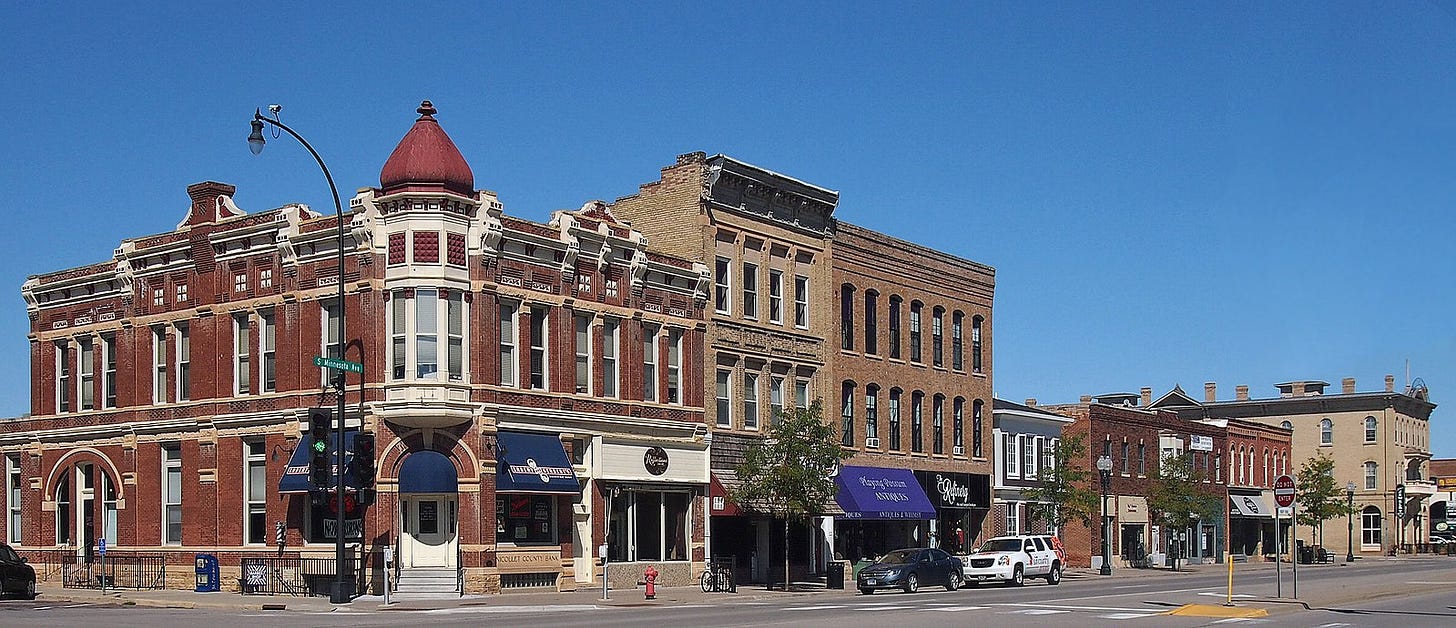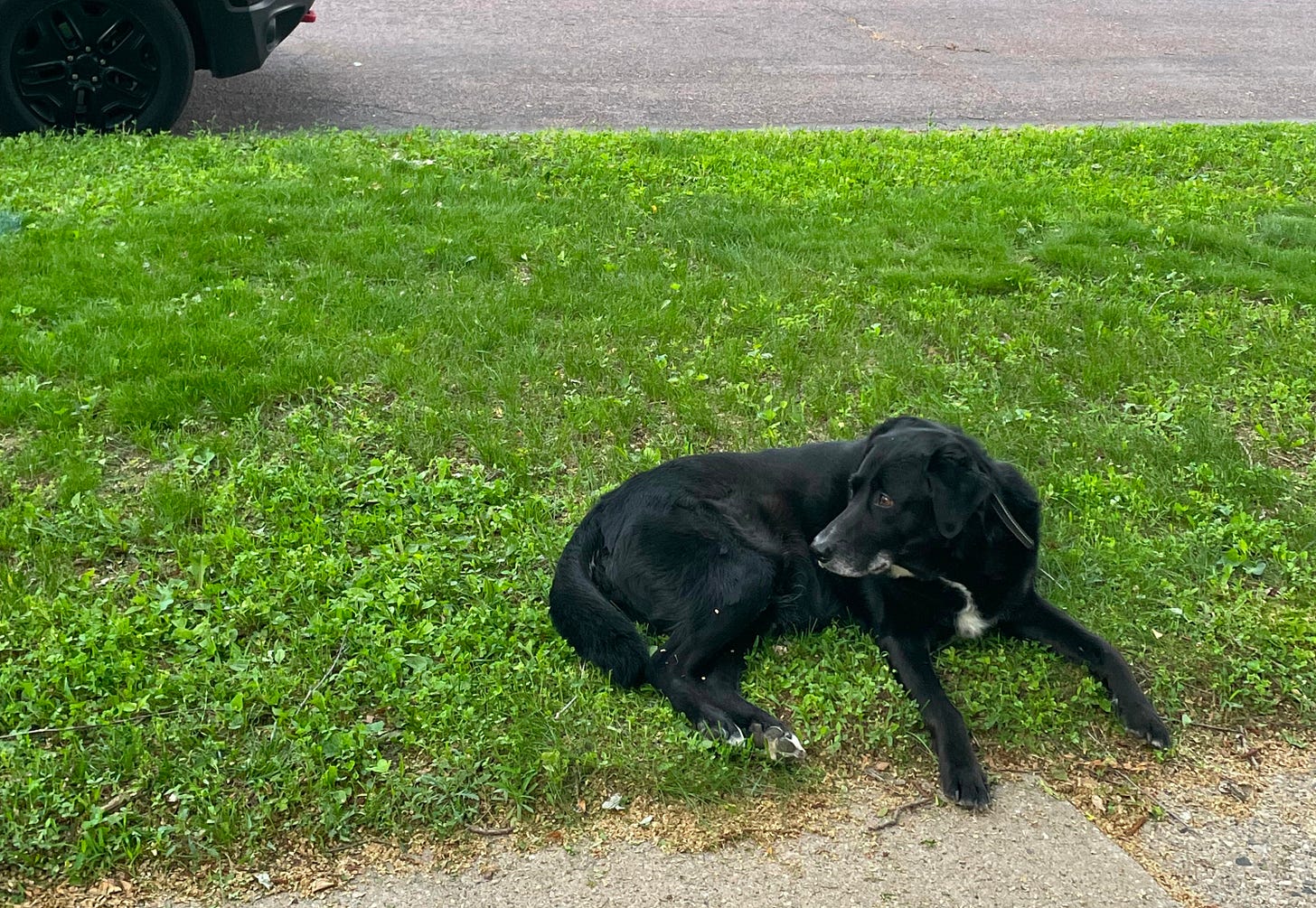I've Been Out Walking
Don't confront me with my failures. I had not forgotten them.

Before I get started, I want to thank the talented Neely Prenzlow for designing the new Bayview Wonder logo. More on the design in an upcoming piece. If you have feedback on the new color background for the blog, please let me know.
Our move to Canada has been a multi-step process that started in earnest at the beginning of 2025.
We spent Christmas together in Pictou, then Hayley stayed in Nova Scotia to begin her position as a professor. She moved into her mother’s basement while I traveled alone back to our home in Saint Peter, Minnesota.
Saint Peter is located about an hour south of the Twin Cities of Minneapolis and St. Paul. It sits in a valley alongside the Minnesota River, at the eastern boundary of the prairies that stretch to the American Rockies and up through western Manitoba, Saskatchewan, and Alberta. The town of 12,000 is the home of the Minnesota Security Hospital and Gustavus Adolphus College, where Hayley and I met in 2016.
Like Pictou, Saint Peter is a town that has made and been made by history more than visitors today might realize. Traverse des Sioux, a Minnesota River crossing for the Dakota people that grew to be an important trading post for the French, is located at the north end of town. It’s also where the Dakota signed the 1851 Treaty of Traverse des Sioux that ceded almost all of southern Minnesota and parts of South Dakota and Iowa to the United States. Just a decade later, the government’s broken promises led to the U.S. - Dakota War of 1862, which reached a grisly culmination with the largest mass execution in U.S. history in Mankato, 15 miles to the south.
Due to its importance in trade and the business interests of some powerful Minnesotans, Saint Peter nearly became the territory’s capital in 1857. An opposing lawmaker stole the signed bill before it got to the governor’s desk and holed up in a hotel room until time ran out. St. Paul, 90 miles northeast but “down” the river, remains the capital to this day. The security hospital opened in 1866 and the complex added an Asylum for the Dangerous Insane in 1911. Today, the security hospital hosts patients at various levels of supervision and containment. The Minnesota Historical Society says the location in Saint Peter was selected “due to its open land; attractive landscapes that would soothe troubled minds; the natural protection provided by nearby bluffs; and access to abundant water and wood.” Some of the old-timers in town say the hospital and associated jobs were a consolation prize for Saint Peter after not becoming capital. Win some, lose some.
Gustavus Adolphus College, where I majored in English, spent most of my career, and met Hayley, came to Saint Peter in 1876.
We live—or I live, for a bit longer anyway—half a block from campus.
I put on some miles walking the streets of Saint Peter in the first half of 2025. You see, the early riser in our marriage had just moved to Canada. I still had the dog.
Duke had to adjust to exercising at supper time rather than first thing in the morning, but he’s the agreeable type. It was a busy spring at work and I felt like I had a lot to juggle, but those daily walks meant I had to stop staring at a screen, look at the scenery, and breathe.
I walked past Saint Peter’s Pearly Gates, a tourism photo opp next to the Chamber of Commerce office down by the river. People in town know the gates are kitschy but either don’t mind or have come to accept it. And there’s some good news about these Pearly Gates: everybody gets in.
I walked past one of the college’s defensive coaches for the football team. He had a pit bull on a leash.
You may be getting the sense that Saint Peter is very literal. Sometimes small towns are. It’s a part of the charm.
I walked past River Rock Coffee and the Arts Center of Saint Peter, where Hayley and I once went on a double date but not with each other. It was before we started dating and she went with my best friend. (That doesn’t clarify much, does it? Too bad, long story.)
I walked past a man around 70 wearing an eye mask and practicing with a white cane as a woman walked by his side. With her hand resting lightly on his elbow, they came slowly down the steps outside the post office. I thought it was just about the kindest, saddest, and most optimistic thing I’d ever seen.
I walked past the Duplex on the corner of 7th and Grace, where I lived with eight roommates as a college senior.
I walked past a man driving a remote control car down the boulevard along the street. When I got closer, I realized the vehicle was a replica of the tour bus for the Govenaires, the five-time world champion drum and bugle corp that’s based in Saint Peter. Visit Patrick’s on Third and enjoy a burger and a beer while you look at the Govies’ memorabilia on the walls.
I walked past a man sitting on a folding chair at the top of his steps, watching the concrete cure on a sidewalk that had been laid a few weeks earlier. He looked more relaxed than I’d felt in years, maybe ever. I wondered what he did for work.
I walked past the stately homes on North Third Street, Saint Peter’s small-town answer to St. Paul’s Summit Avenue.
I walked past a woman smoking a cigarette across the street from a transitional home.
I walked past a middle-aged man using a leaf blower in one of the parks. He wasn’t a Parks and Rec employee. Was he volunteering? Was he unhappy with the city’s lawn care? I was about to ask what makes a person so passionate about leaf management, but Duke didn’t like the sound of the machine. We marched on.
I walked past the parking lot where picnic tables had been set up for the fire department dance that takes place every year on July 3. The day after, thousands of people would line the streets of Saint Peter for the parade and the “Old Fashioned Fourth of July” events in Minnesota Square Park.
I walked while listening to music. I walked while having arguments in my head. I walked and problem solved. I walked and worked. I walked and talked on the phone. I walked and thought. I tried all the different kinds of walking, really.
I’ll be back in Saint Peter soon, wrapping up a few months of work while my immigration clock continues to tick towards residency. It’ll be hard to leave Pictou, but there’s at least one consolation: I’m looking forward to some more miles in the river valley.
One day in late June, shortly before Hayley arrived for our road trip to Nova Scotia with the dog, I walked down the sidewalk and was ambushed by three little girls with guns. Fortunately, they were loaded with nothing more than soapy water.
They popped out from behind a tree and asked if I wanted bubbles.
Of course.
Duke and I walked through a cascade of shimmering rainbows and back up College Avenue towards home.





An interesting side note to your post, JJ, is that the Minnesota Security Hospital was the inspiration for one of our currently funded research projects, which is investigating patient admissions to the Nova Scotia Hospital b/w 1860-1900. When I taught a January term at Gustavus, the class and I did a field trip to the St. Peter State Hospital Museum. Despite being quite familiar with the history of psychopathology, the tour was illuminating and the students loved it. It made me wonder why we didn’t have a similar offering in Nova Scotia. Our project includes a number of undergrads, a narrative portraiture researcher from the University of Edinburgh, and a local visual portraiture artist. Soon, we will be launching a virtual museum to begin disseminating findings. We are indebted to the staff of the St. Peter Museum for their inspiration!